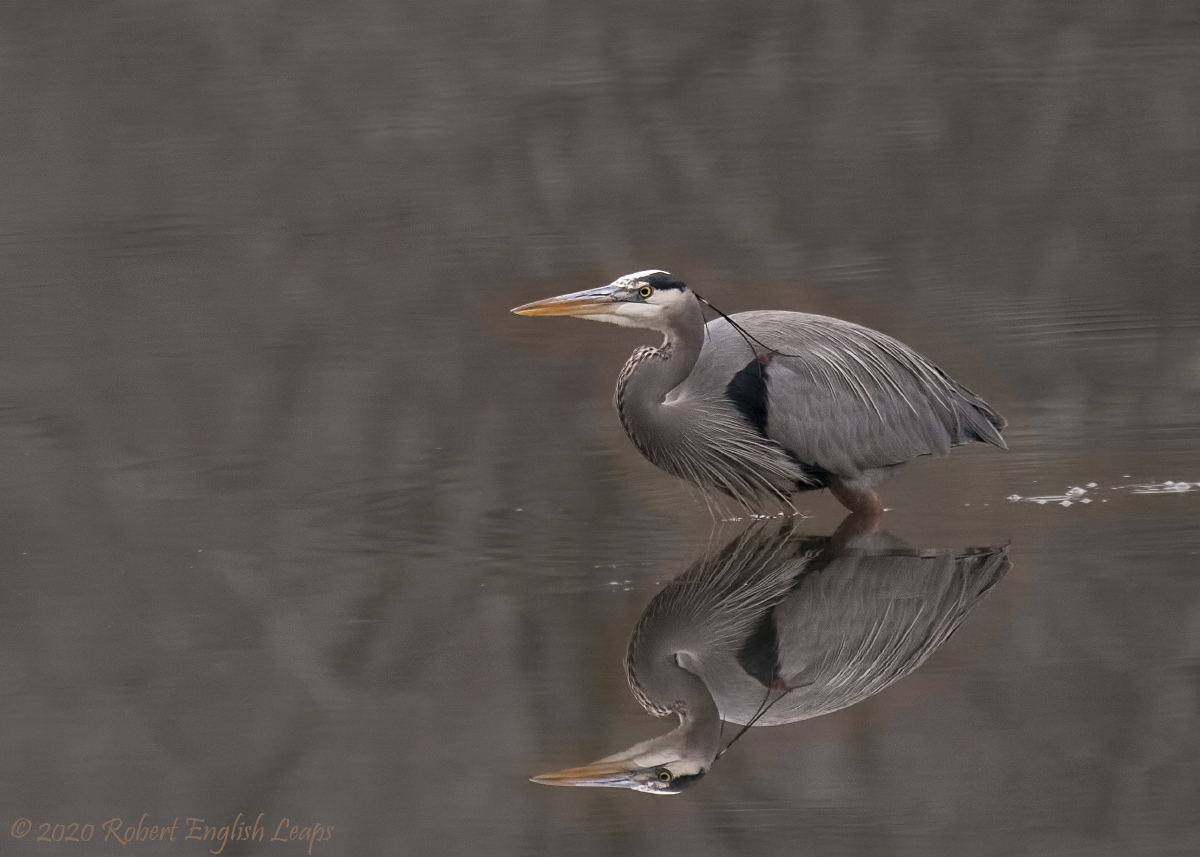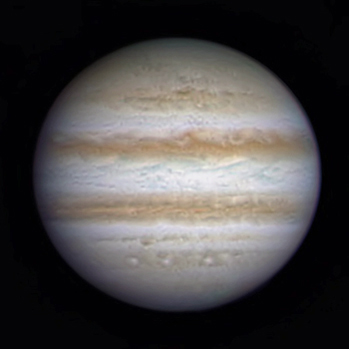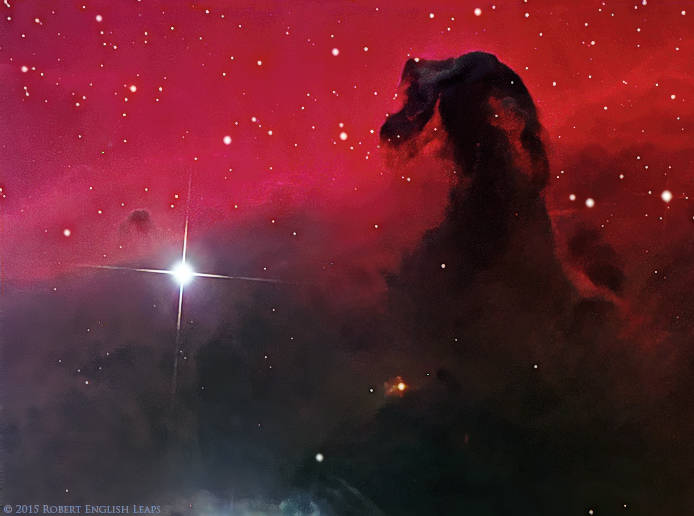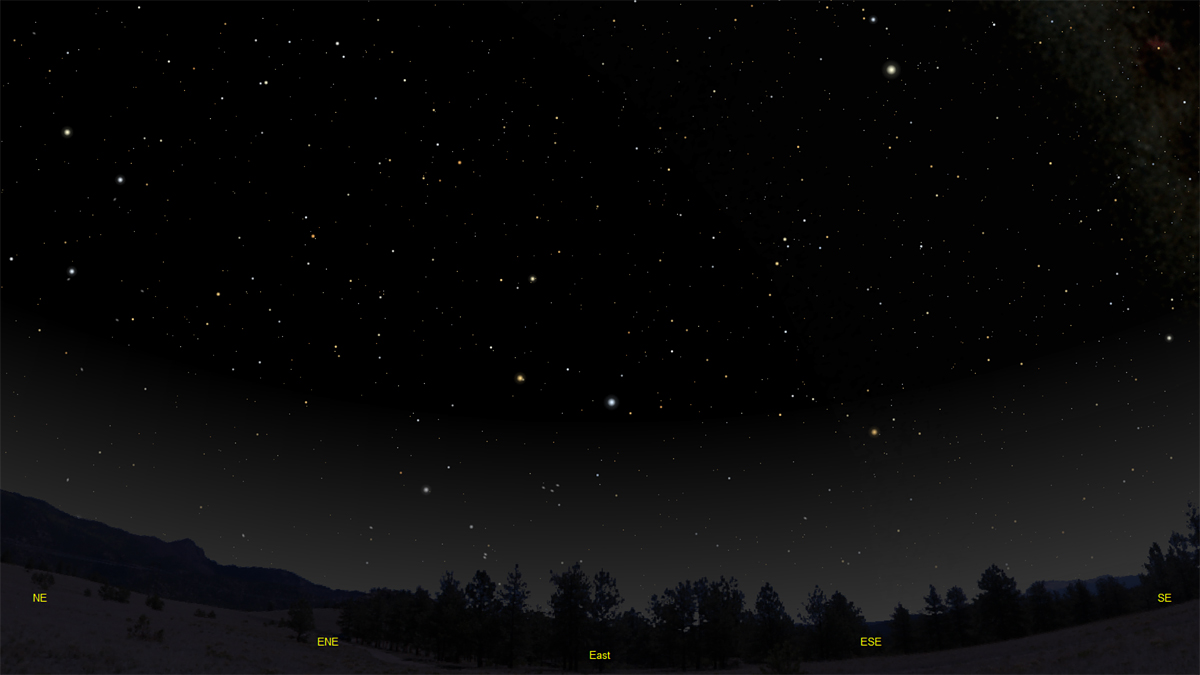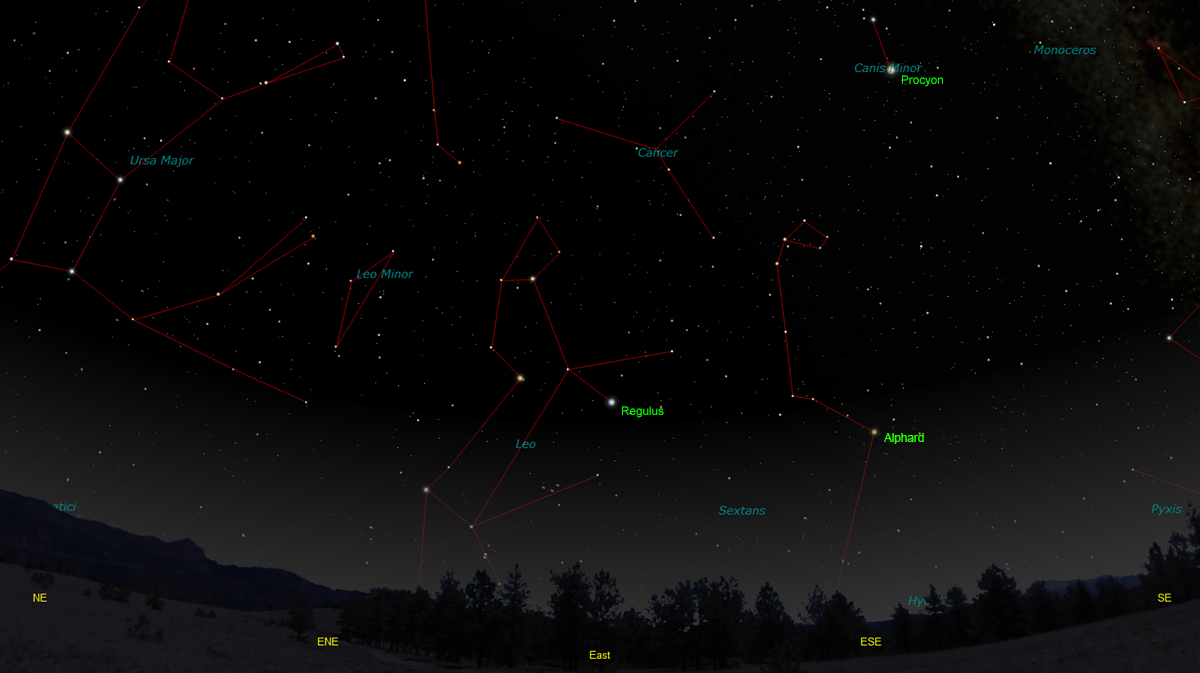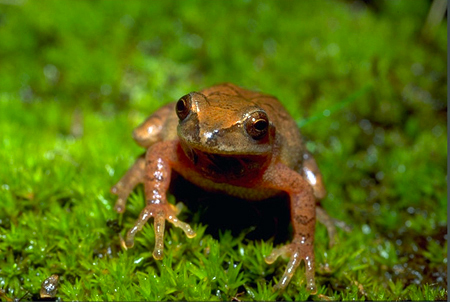The purpose of this feature is to give scout leaders, educators and naturalists an idea of some of the natural events coming up each month. We will try to cover a variety of natural events ranging from sky events to calling periods of amphibians, bird and mammal watching tips, prominent wildflowers and anything else that comes to mind. We will also note prominent constellations appearing over the eastern horizon at mid-evening each month for our area for those who would like to learn the constellations. If you have suggestions for other types of natural information you would like to see added to this calendar, let us know! Note: You can click on the hyperlinks to learn more about some of the featured items. To return to the Calendar, hit the "back" button on your browser, NOT the "back" button on the web page. All charts are available in a "printer friendly" mode, with black stars on a white background. Left clicking on each chart will take you to a printable black and white image. Though we link book references to nationwide sources, we encourage you to support your local book store whenever possible.
Notes From December 2019 Despite the hectic pace of the holidays, we did manage to get out and do a little birding. We drove up to Land Between the Lakes National Recreation Area on a blustery winter morning and walked the trail along Honker Lake. We saw our most interesting species sitting on a log beside the lake and scanning with binoculars. Two immature Bald Eagles road chased one another out on the lake and a White Pelican rose from the water, showing off its 9-foot wingspan. Several Boneparte's Gulls wheeled about and a Double-crested Cormorant flew by low and fast. Far out on the lake we saw two Ruddy Ducks riding the waves, their small size and distance making them look like rubber toys. Even so, their small upright tails were visible. We later came across another group of the Ruddy Ducks close by, along with a couple of Horned Grebes and a nice group of Buffleheads. Near Ashland City, Tennessee we came across a Ross's Goose among a flock of Canada Geese on Christmas day. I went back to photograph it the following morning and it was nowhere to be seen. I did come across a Great Blue Heron stalking its way across a small pond in the early morning light, and took a few shots of it.
Great Blue Herons start working on their nests this time of year, and this one is already showing breeding plumage. The nests are in colonies, which can include 500 or more individual nests. Nests are mostly constructed of sticks woven together by the female and lined with pine needles, moss and dry grasses. Great Blue Herons are the largest North American heron, standing around four feet tall and having a wingspan of six feet.
Sky Events for January 2020: The Quandrantid Meteor Shower peaks around 3:20EST on the morning of January 4th. This shower usually has a very brief peak. The period from 2:00am till dawn should be the best time for observing. Look toward the east-northeast towards the constellation Bootes. The debris that causes the shower originates with the asteroid 2003 EH1.
Morning Sky: Look for Mars in the southeastern sky before sunrise at the beginning of the month. It will be above the bright star Antares in Scorpius. The red planet moves from Libra across northern Scorpius into Ophiuchus this month. It's still tiny in a telescope's field of view, with an apparent diameter of less than 5 arc seconds. Towards the end of the month watch for Jupiter and then Saturn to appear low in the southeast before sunrise. Evening Sky: Venus is the first star like object to appear in the southwestern sky after sunset. As the month goes on it will appear higher and higher above the horizon each evening. It will reach maximum elongation from the Sun in late March. Watch for Mercury in the southwestern sky the last few days of the month. Start your search about 40 minutes after sunset. It helps to have a clear flat southwestern horizon. It will continue to climb above the horizon each evening in early February.
The views below show the sky looking east at 10:00pm EST on January 15th. The first view shows the sky with the constellations outlined and names depicted. Star and planet names are in green. Constellation names are in blue. The second view shows the same scene without labels. Look for the bright stars Castor and Pollux in the constellation of Gemini, The Twins. Compare the colors of the bright stars Betelgeuse and Rigel in Orion. Betelgeuse is a red giant and Rigel is a very hot, blue-white supergiant. If you have a telescope or binoculars, look at the center of the three "sword" stars below Orion's belt. There you will find the Orion Nebula, M42, one of the most magnificent emission nebulas in the sky. The red glow of hydrogen alpha light is visible only in very large telescopes and the nebula appears as a small greenish glow in small telescopes. Crouching beneath the feet of Orion, is Lepus, the Hare. Sirius, the brightest star in the sky, shines below Orion. Sirius is in Canis Major, the Great Dog, and for that reason is known as the Dog Star. In the late summer, Sirius rises at the same time as the Sun. Because of this, the late summer days are known as the "dog days." The faint constellation Monoceros, the Unicorn, follows Orion over the eastern horizon. Low in the eastern sky below Gemini is Canis Minor, with its bright star Procyon. Procyon means, "before the dog," and refers to the fact that Procyon rises just before the Dog Star, Sirius. Look below Gemini and see if you can spot the faint glow of M44, the "Beehive Cluster." This cluster is located in Cancer, the Crab. If you are in clear dark moonless skies and have a hydrogen beta nebula filter, it's a good time to search for the elusive Horsehead Nebula, located near the lowest star in Orion's belt. You won't see the colors or the detail that you see in the long exposure image above. Just finding a small notch in the faint hydrogen alpha nebula is about all you can expect, even with a large telescope. On Learning the Constellations: We advise learning a few constellations each month, and then following them through the seasons. Once you associate a particular constellation coming over the eastern horizon at a certain time of year, you may start thinking about it like an old friend, looking forward to its arrival each season. The stars in the evening scene above, for instance, will always be in the same place relative to the horizon at the same time and date each January. In particular, learn the brightest stars (like Regulus and Procyon in the above scene), for they will guide you to the fainter stars. Once you can locate the more prominent constellations, you can "branch out" to other constellations around them. It may take you a little while to get a sense of scale, to translate what you see on the computer screen or what you see on the page of a book to what you see in the sky. Look for patterns, like the stars of Leo. The earth's rotation causes the constellations to appear to move across the sky just as the sun and the moon appear to do. If you go outside earlier than the time shown on the charts, the constellations will be lower to the eastern horizon. If you observe later, they will have climbed higher. As each season progresses, the earth's motion around the sun causes the constellations to appear a little farther towards the west each night for any given time of night. If you want to see where the constellations in the above figures will be on February 15th at 10:00pm EST, you can stay up till 12:00am EST on the January 15th and get a preview. The westward motion of the constellations is equivalent to two hours per month. Recommended: Sky & Telescope's Pocket Star Atlas is beautiful, compact star atlas. A good book to learn the constellations is Patterns in the Sky, by Hewitt-White. You may also want to check out at H. A. Rey's classic, The Stars, A New Way to See Them. For sky watching tips, an inexpensive good guide is Secrets of Stargazing, by Becky Ramotowski.
A good general reference book on astronomy is the Peterson
Field Guide,
A Field Guide to the Stars and Planets, by Pasachoff. The book retails for around $14.00.
The Virtual Moon Atlas is a terrific way to learn the surface features of the Moon. And it's free software. You can download the Virtual Moon Atlas here. Apps: We really love the Sky Safari 6 Pro. It is available for both iOS and Android operating systems. There are three versions. The Pro is simply the best astronomy app we've ever seen. The description of the Pro version reads, "includes over 100 million stars, 3 million galaxies down to 18th magnitude, and 750,000 solar system objects; including every comet and asteroid ever discovered." A nother great app is the Photographer's Ephemeris. Great for finding sunrise, moonrise, sunset and moonset times and the precise place on the horizon that the event will occur. Invaluable not only for planning photographs, but also nice to plan an outing to watch the full moon rise. Available for both androids and iOS operating systems.
Amphibians:
A lot of things happen with amphibians in January. To see them, though, you have to be out in the sort of weather that makes most people stay indoors. The trick is to go out on mild (50 degrees Fahrenheit or warmer) rainy nights. For safety, it is important that you have another person with you to watch for traffic as you slowly drive the back roads, looking for things that cross the road in front of you. Make frequent stops to listen for calling frogs. In January, both Spring Peepers and Upland Chorus Frogs are not uncommon, and Wood Frogs have their short-lived breeding choruses in woodland ponds. Southern Leopard Frogs are also sometimes calling on mild January nights. I have seen Northern Cricket Frogs, Green Frogs, American Bullfrogs and American Toads foraging in January. And just about anything is possible. On January 22, 1999, I found an Eastern Spadefoot out in the stormy weather. That same day a tornado ripped through Clarksville, Tennessee, doing much damage to the Austin Peay campus. January is an exciting time of year to look for herps! This is also the time to look for Tiger Salamander and Streamside Salamander egg masses. Tiger Salamanders like to deposit their egg masses on the vegetation in shallow water in small ponds and wetlands. Streamside Salamanders deposit their egg masses on the bottoms of rocks in streams. If you are looking for salamanders, always remember to carefully replace any stones you pick up exactly where you found them. Recommended: The Frogs and Toads of North America, Lang Elliott, Houghton Mifflin Co. Archives (Remember to use the back button on your browser, NOT the back button on the web page!) Natural Calendar December 2019 Natural Calendar November 2019 Natural Calendar September 2019 Natural Calendar February 2019 Natural Calendar December 2018 Natural Calendar November 2018 Natural Calendar February 2018 Natural Calendar December 2017 Natural Calendar November 2017 Natural Calendar October 2017Natural Calendar September 2017 Natural Calendar February 2017 Natural Calendar December 2016 Natural Calendar November 2016 Natural Calendar September 2016Natural Calendar February 2016 Natural Calendar December 2015 Natural Calendar November 2015 Natural Calendar September 2015 Natural Calendar November 2014 Natural Calendar September 2014 Natural Calendar September 2013 Natural Calendar December 2012 Natural Calendar November 2012 Natural Calendar September 2012 Natural Calendar February 2012 Natural Calendar December 2011 Natural Calendar November 2011 Natural Calendar September 2011 Natural Calendar December 2010 Natural Calendar November 2010 Natural Calendar September 2010 Natural Calendar February 2010 Natural Calendar December 2009 Natural Calendar November 2009 Natural Calendar September 2009 Natural Calendar February 2009 Natural Calendar December 2008 Natural Calendar November 2008 Natural Calendar September 2008 Natural Calendar February 2008 Natural Calendar December 2007 Natural Calendar November 2007 Natural Calendar September 2007 Natural Calendar February 2007 Natural Calendar December 2006 Natural Calendar November 2006 Natural Calendar September 2006 Natural Calendar February 2006
Natural Calendar December 2005
Natural Calendar November 2005
Natural Calendar September 2005
Natural Calendar February 2005
Natural Calendar December 2004
Natural Calendar November 2004
Natural Calendar September 2004
Natural Calendar February 2004
Natural Calendar December 2003
Natural Calendar November 2003 Natural Calendar February 2003 Natural Calendar December 2002 Natural Calendar November 2002 Nature Notes Archives: Nature Notes was a page we published in 2001 and 2002 containing our observations about everything from the northern lights display of November 2001 to frog and salamander egg masses. Night scenes prepared with The Sky Professional from Software Bisque All images and recordings © 2020 Leaps
|
|
